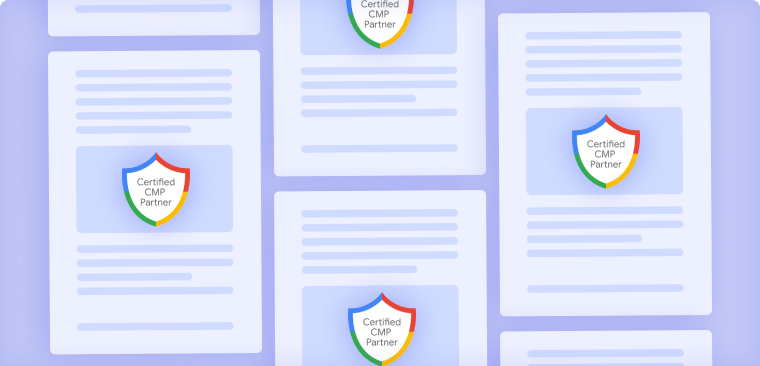How Google's Consent Mode v2 Impacts Your Data Collection
May 01, 2025
•
4 min read
Table of contents
back
to the top
If you're using Google Ads or Analytics in the EU, there’s a major change you can’t afford to ignore. With the rollout of Google Consent Mode v2, your website’s ability to collect and use marketing data now depends on whether you’ve implemented the right consent mechanism — and how well it aligns with strict GDPR requirements.
In this post, we’ll explain what Consent Mode v2 is, how it affects your data collection, and the essential considerations to protect your marketing performance and stay on the right side of privacy laws.

What Is Google Consent Mode v2?
Let’s start with the basics.
Google Consent Mode v2 is an updated framework that allows your website to adjust how Google products behave based on a user’s consent choices. It helps businesses comply with European privacy laws by giving users more control over how their data is processed.
Here’s what’s new:
Two additional consent signals must now be collected and passed to Google:
ad_user_data– Indicates whether the user allows their personal data to be used for advertising purposes.ad_personalization– Controls whether Google can show personalized ads to that user.
These new signals join the existing ones:
ad_storage– Governs ad-related cookies.analytics_storage– Governs analytics-related cookies.functionality_storage– Controls cookies that support site functionality (e.g. language).security_storage– Controls cookies for security-related functions (e.g. fraud prevention).personalization_storage– Controls cookies used to remember preferences (e.g. themes, interests).
When users deny consent, Google adjusts how data is processed and may use modeled data to estimate conversions — helping advertisers maintain insights without violating privacy laws.
Why Consent Mode v2 Affects Your Tracking
1. It’s Mandatory in the EU
If you’re serving users in the European Economic Area and using Google services, Consent Mode v2 is no longer optional. Google now requires you to use a Google-certified Consent Management Platform (CMP) to collect and send valid consent signals.
Without it, expect a significant impact on:
- Conversion tracking
- Analytics reliability
- Remarketing and personalization
2. It Limits or Enables Data Collection
If a user denies consent:
- Google can’t store cookies or track user behavior.
- Personalization features like remarketing won’t function.
- Google Ads may lose attribution visibility.
With proper setup, Google Consent Mode v2 allows modeling to help fill in the gaps — but only if you’ve passed the correct consent signals through a compliant CMP.
Common Compliance Mistakes
1. Using an Uncertified CMP
Many platforms do not meet Google’s latest certification requirements or support the IAB TCF v2.2 framework — both of which are now essential for compliance.
2. Omitting Signals
While most websites implement ad_storage and analytics_storage, they often overlook the newer ad_user_data and ad_personalization signals. For full compliance with Consent Mode v2 and proper data governance, all seven signals should be implemented:
ad_storageanalytics_storagead_user_dataad_personalizationfunctionality_storagesecurity_storagepersonalization_storage
3. Letting Tags Fire Before Consent
Even with Consent Mode enabled, allowing Google tags to fire before the user gives consent is a GDPR violation.
4. Not Maintaining Consent Records
Under the GDPR, organizations must keep a detailed log of user consent — including what was shown, what was selected, and when the consent was given.
How CookiePal Makes Consent Mode v2 Compliance Simple
CookiePal.io is purpose-built for Consent Mode v2 and GDPR compliance.
Key features:
- Google-certified CMP with full support for all required Consent Mode signals
- Automatic integration with
gtag.jsand Google Tag Manager (GTM) - Granular user controls for all consent signals
- Real-time consent record storage and reporting for GDPR and regulatory compliance
Final Takeaway
Google Consent Mode v2 changes the rules for how you collect data — and how you run ads — in the EU. Without a proper setup, your tracking will break, and your compliance may be at risk.
By using a certified CMP, passing all required signals, and correctly managing your Google tags, you can protect your data, your ads, and your brand’s reputation.
Sources
Explore further

Comprehensive Guide to Managing Cookies in Wordpress
A complete guide to managing cookies in WordPress, including compliance, consent prompts, monetization, and tracking with tools like Facebook Pixel.
March 10, 2025
4 min

Is Google Consent Mode Enough for GDPR Compliance
Is Google Consent Mode enough for GDPR? Learn what it does, its limitations, and why you need a Google‑certified CMP for true compliance—all in one concise guide.
July 25, 2025
4 min

Understanding Cookie Policies: A Comprehensive Guide for Website Owners
A clear cookie policy builds trust and ensures compliance. This guide covers key details, risks, and its difference from a privacy policy.
March 24, 2025
3 min



